If you don’t have a data allowance on your iPhone or other mobile phone, could you survive by just relying on places offering free WiFi?
These days my mobile data connection is almost more important than my home broadband, offering me an online lifeline from boredom when out shopping or visiting people. However, I began wondering if it is possible to survive without a mobile data connection, relying only on WiFi.
Two things sparked this off. Firstly, I had considered switching to an original iPhone and its slower GPRS/EDGE mobile connection speed is okay for emailing, but surfing is painful unless you are in a WiFi zone. Secondly, I have a friend who has no data allowance on his pay-as-you-go Android phone, and he seems to manage using WiFi only.
WiFi used to be limited to locked home and corporate networks, requiring WEP and WPA keys to access them, but these days more and more places – such as restaurants, fast food outlets and coffee houses – are offering free WiFi access to entice you in.
Before I begin, I should point out I am in the UK, and WiFi coverage outside of homes will vary from city to city and country to country.
Let’s Experiment
I live in a small town with a small high street. With my iPhone set to search mode, I picked up a few free WiFi networks: one was Barclays Bank, which seems on all the time, even when the bank is closed, and a couple of local cafes, which were not open and required a key to get in to them.
Whilst on a recent trip to my nearest large city centre, I decided to repeat the experiment. A crowded high street and several shopping malls should turn up some good free and open networks.
I was travelling via bus, and whilst at the bus stop my end I was a few feet away from my local Barclays Bank, connected and checked my emails.
I left my small town at 1 p.m. and arrived in the big city at 2 p.m. No wireless networks found whilst traveling was the first downside. Our first stop was to grab some food. Walking towards the local shopping mall, the first to pop up was The Cloud. While it doesn’t ask for a security code, my iPhone wouldn’t surf, just faced with a login page. The Cloud is a subsidiary of BSkyB and has 11,000 hotspots in various shops across the UK.
Update: The Cloud requires an app to be installed and a profile setting put on your iPhone. The app will then search for local hot spots. The app shows over 30 hotspots in that city centre, so maybe I would have had better luck if I had known this beforehand.
As I entered the shopping mall, I walked past two or three mobile phone outlets, and the next open WiFi network was called O2 WiFi. This is another hotspot provider, and while you do need to sign up, it is totally free, and once signed up you don’t need to sign up again when you find another O2 WiFi. You can even sign up on your handset.
A few minutes later an unrecognised network – TR4-10046 – was found, connected and surfed it fine. This must have been an independent shop.
In an escalator and a few floors up, faced with a food hall but only one free open network – yet another O2 WiFi supplied by Pizza Hut. Because I had already signed up for O2 WiFi previously, it connected without a problem. I noticed Kentucky Fried Chicken had a sign up saying ‘free WiFi’ – which I had previously used on a prior visit with a different device, but it didn’t show up this time on my iPhone or my wife’s Android, so I presume it was down.
According to the O2 WiFi hotspot checker, there are five other network points in that shopping mall alone and a further 17 within a mile.
After a meal and checking my emails using the Pizza Hut WiFi, we off again, down a level, and on leaving the mall another restaurant, Calluccios, offered totally free WiFi, to which I connected and did a bit of browsing.
A wander towards the other end of the city centre, and while there were plenty of WiFi networks, none of them were open. BTWiFi, the new name for BTOpenZone, popped up a number of times (as well as some called BTOpenZone). This is similar to TheCloud, however, this one isn’t free unless you use BT as your home broadband provider, but they do offer different access lengths.
Walking back I passed yet another Pizza Hut and another O2 WiFi network. A few more steps and ‘M&S Free WiFi’ popped up and connected, but I couldn’t surf and could see no login page.
My final free hotspot was at the bus station called first-WiFi, although I think it was actually on a bus and not the station. Some of our buses have free WiFi on them. Great if you have a long journey.
Results
This was my first trip out with my spare phone, and it collected quite a few hotspots in its memory, great for when I go back, but for someone who travels around hoping for lots of free WiFi, this could be a bit hit or miss.
In the two hours I was in the big city, I connected to about five networks successfully, surfing and emailing. If I had signed up to The Cloud before I went out and or paid for BTOpenZone/BTWiFi, then I would have had a better chance of having 60-70% WiFi coverage. But relying totally on free hotspots is difficult.
A lot of cafes do offer free internet, but you need to buy something to get the code – and I presume it changes daily or weekly to prevent you from getting it once and then latching on forevermore without further purchases.
Small towns tend to be limited to a few cafes and possibly some larger bank branches. Then there is travelling, where you have miles and miles of roads and only a few food establishments or motorway services, which possibly could offer free WiFi.
Security Issues
Using free and open networks could cause security issues. If you are using sensitive data, online banking, or online shopping, you might be at risk of hacking.
Battery Life
One extra bonus of using only WiFi is battery life. 3G is heavy on battery, especially if you have a lot of push apps coming in; WiFi is a lot faster and easier on battery consumption.
Could It Be Done?
Depending on your level of need and depending on your location or travelling habits depends on whether being with a mobile data allowance is doable. If you live or work in a big city and only need to read emails while on lunch or catch up on Facebook while walking to your place of work, then you could get away with relying on WiFi only.
However, if like me you live in a small town which you spend 80% of your time in and once you leave your home you are reliant on one or two hotspots, having no data allowance would seriously hinder my online usage.
If you have no choice, WiFi is a good option. It’s free. You don’t even need a SIM in your phone – or even a phone, an iPod touch, iPad, or tablet will give you the same option.
Conclusion: Is It For Me?
For the price of cheap SIM only deals that include data, it is a no brainer for me. Relying on WiFi only with a newer iPhone means iMessage only comes in when you have a data connection – that’s not reliable enough, not for me.
I pay £6 for 800 minutes, unlimited SMS, and 1 GB data. That is cheaper than even signing up to WiFi cloud services and gives you total coverage whereever you are – plus you have your WiFi too.
The short answer is, for me, WiFi only is not a viable option.
Of course, this is all subjective. Ten years ago, mobile data was rare, expensive, and classed as nerdy. Do we need to be online all the time? Do we need to be able to post a picture to Facebook whilst having a picnic in the middle of nowhere? Is it imperative we read and reply to an email as soon as it arrives?
Follow Simon Royal on Twitter or send him an Email.
Like what you have read? Send Simon a donation via Tip Jar.
keywords: #wifi #mobile #smartphone #wifionly #hotspot #free #techspectrum #simonroyal
short link: http://goo.gl/eGiC3v
searchword: wifionly

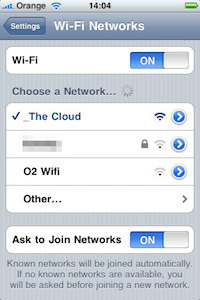
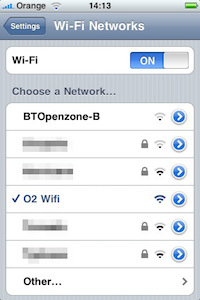
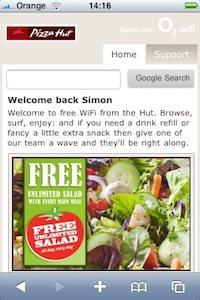
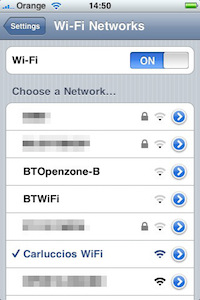
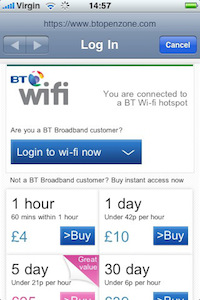



I would tend to agree with your conclusion – but it depends… I’ve tried variations of your experiment for years, mostly when travelling. For instance, I went to NYC one time with an iPod Touch. Up until fairly recently, I found usable WiFi connections rarer than I thought they would be, or more limited – for instance, Rome’s promised free WiFi in parks turned out to require a log-in with an Italian cell phone #…. something I didn’t have. Last few trips, while WiFi access has improved, I’ve taken to travelling with an unlocked smartphone – both in US and Europe, temporary phone accounts with more than enough data are cheap enough to be worthwhile (US$3/day on T-Mobile USA, for instance, or Euro15 for a month of service on Vodafone Italia).
But for ongoing service, Canadian phone+data plans are relatively expensive – and Canadian home broadband provider Shaw offers customers access to a large number of WiFi hotspots, with a smartphone app to make them easy to locate. So this might be a more attractive option for those customers. Certainly Shaw would like them to think so!
So like I said, it depends!
Interesting, Simon. I carry two phones: one is my actual phone (a cheap basic phone) and the other is a Samsung Galaxy II. The Galaxy is not connected, and is my music player, camera, game device, etc. I got it free and it doesn’t cost me anything per month, and I get 80% of the device’s functions.
I’ve yet to feel deprived of internet, because most places I go have WiFi… or I just do without. It’s a nice system for me.